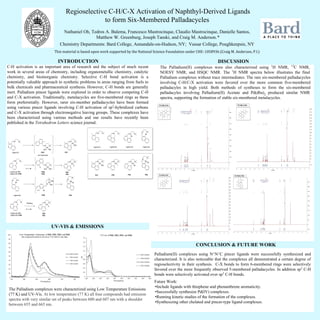
Francesco, Claudio, Danielle Pd 2016 BSRI Poster.pptx
- 1. The Palladium(II) complexes were also characterized using 1 H NMR, 13 C NMR, NOESY NMR, and HSQC NMR. The 1 H NMR spectra below illustrates the final Palladium complexes without trace intermediates. The rare six-membered palladacycles involving C-H/C-X activation were favored over the more common five-membered palladacyles in high yield. Both methods of syntheses to form the six-membered palladacyles involving Palladium(II) Acetate and Pd(dba)2 produced similar NMR spectra, supporting the formation of stable six-membered metalacycles. Palladium(II) complexes using N^N^C pincer ligands were successfully synthesized and characterized. It is also noticeable that the complexes all demonstrated a certain degree of regioselectivity in their synthesis. C-X bonds to form 6-membered rings were selectively favored over the more frequently observed 5-membered palladacycles. In addition sp2 C-H bonds were selectively activated over sp3 C-H bonds. Future Work: •Include ligands with thiophene and phenanthrene aromaticity. •Successfully synthesize Pd(IV) complexes. •Running kinetic studies of the formation of the complexes. •Synthesizing other chelated and pincer-type ligand complexes. UV-VIS & EMISSIONS CONCLUSION & FUTURE WORK Regioselective C-H/C-X Activation of Naphthyl-Derived Ligands to form Six-Membered Palladacycles Nathaniel Oh, Tedros A. Balema, Francesco Mastrocinque, Claudio Mastrocinque, Danielle Santos, Matthew W. Greenburg, Joseph Tanski, and Craig M. Anderson.* Chemistry Departments: Bard College, Annandale-on-Hudson, NY; Vassar College, Poughkeepsie, NY This material is based upon work supported by the National Science Foundation under CHE–1058936 (Craig M. Anderson, P.I.) INTRODUCTION DISCUSSION C-H activation is an important area of research and the subject of much recent work in several areas of chemistry, including organometallic chemistry, catalytic chemistry, and bioinorganic chemistry. Selective C-H bond activation is a potentially valuable approach to synthetic problems in areas ranging from fuels to bulk chemicals and pharmaceutical synthesis. However, C-H bonds are generally inert. Palladium pincer ligands were explored in order to observe competing C-H and C-X activation. Traditionally, metalacycles are five-membered rings as these form preferretially. However, rarer six-member palladacycles have been formed using various pincer ligands involving C-H activation of sp2 -hybridized carbons and C-X activation through electronegative leaving groups. These complexes have been characterized using various methods and our results have recently been published in the Tetrahedron Letters science journal. The Palladium complexes were characterized using Low Temperature Emissions (77 K) and UV-Vis. At low temperature (77 K) all four compounds had emission spectra with very similar set of peaks between 600 and 607 nm with a shoulder between 655 and 665 nm.